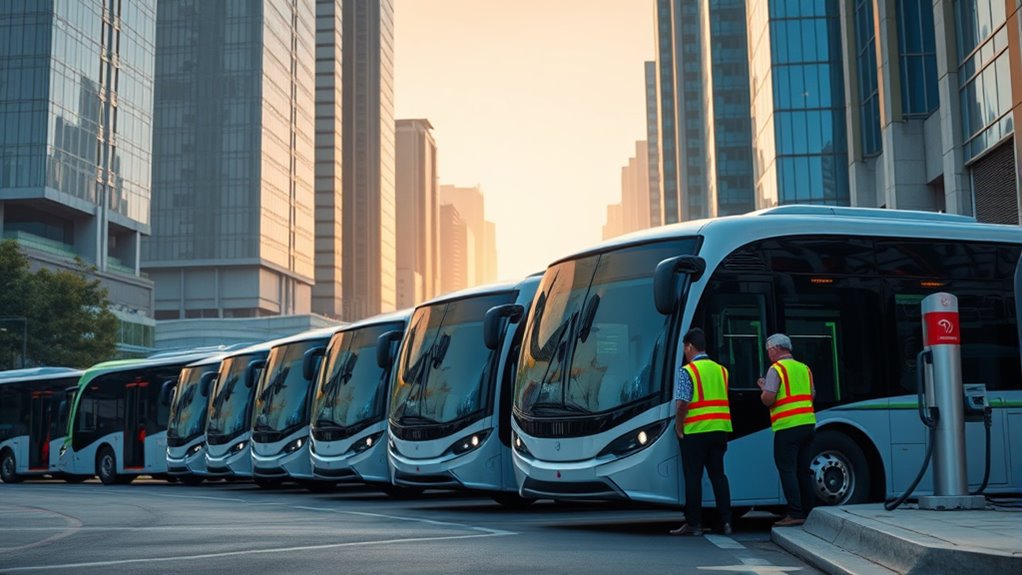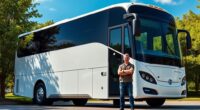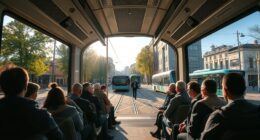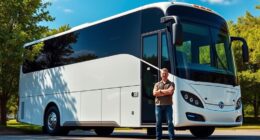In Shenzhen, your electric bus guarantees you can comfortably run 350 km daily thanks to a well-designed charging infrastructure. Strategic stations at depots and key routes let you quickly top up during breaks, keeping downtime minimal. Smart charging adapts to your schedule, making sure you’re always ready. The silent, clean operation creates a more comfortable working environment and supports the city’s eco-friendly goals. To discover more about how this system works, keep exploring the full story.
Key Takeaways
- Drivers benefit from well-placed charging stations that enable quick top-ups during short breaks, ensuring buses are always ready.
- Electric buses operate silently and without engine fumes, creating a healthier and more comfortable environment for drivers.
- Smart, adaptive charging systems help drivers manage routes efficiently, minimizing downtime and boosting operational reliability.
- Reduced maintenance needs and fewer breakdowns improve schedule adherence and driver confidence during daily operations.
- Overall, drivers experience increased morale and pride working with Shenzhen’s advanced, eco-friendly electric fleet.
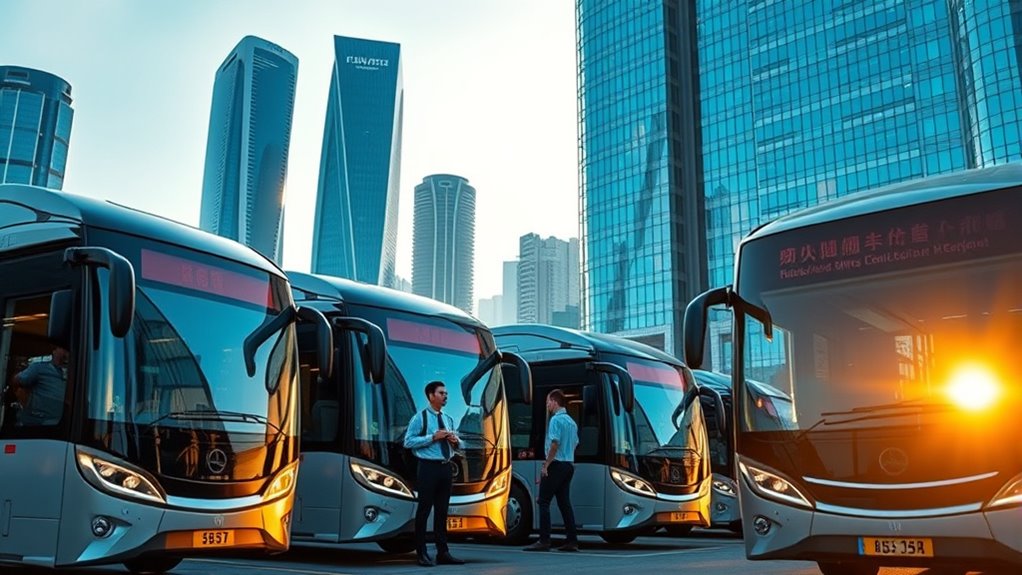
Shenzhen has transformed its public transportation system by deploying one of the world’s largest all-electric fleets. As a driver steering this extensive network, you quickly notice the significant changes in your daily routine, especially when it comes to charging infrastructure. The city has invested heavily in creating a well-distributed, reliable charging network that keeps your buses running smoothly throughout the day. Instead of worrying about frequent stops for fuel, you now rely on strategically placed charging stations that are easily accessible at depots and key points along your route. This infrastructure minimizes downtime, allowing you to focus on providing consistent service to passengers. The fast-charging capabilities mean you can quickly top up your vehicle during short breaks, which is vital when you’re running a demanding schedule covering 350 kilometers daily. This seamless charging process boosts your confidence, knowing you won’t be stranded due to a depleted battery.
Your driver experiences have improved markedly with this shift to electric. The silent operation of the buses makes the driving experience more comfortable, and you appreciate the reduced noise pollution compared to traditional diesel engines. This quieter environment helps you stay alert and reduces fatigue during long shifts. Moreover, the absence of engine fumes creates a healthier workspace, enhancing your well-being and that of your passengers. The shift to electric buses also means fewer maintenance issues, since electric motors have fewer moving parts. This reliability translates into fewer breakdowns and less time spent on repairs, allowing you to stick to your schedule more consistently. Many drivers report that operating these buses feels more modern and efficient, boosting morale and pride in working for a city leading the way in sustainable transportation.
The charging infrastructure is designed with your needs in mind, emphasizing convenience and efficiency. Charging stations are often located near depots or along bus routes, reducing the need for long detours. Some stations even offer smart charging options that adapt to your schedule, ensuring your bus is ready right when you need it. This intelligent system helps you manage your route more effectively, avoiding delays caused by charging issues. Overall, the experience of driving these electric buses is increasingly positive, thanks to the well-planned infrastructure and the many benefits of electric vehicles. As you continue to operate within this eco-friendly network, you become part of a broader effort to reduce emissions and improve urban air quality. Your daily work not only moves people efficiently but also contributes to Shenzhen’s leadership in sustainable urban mobility. Additionally, advancements in charging technology are expected to further enhance operational efficiency and reduce downtime for drivers.
Frequently Asked Questions
How Do Electric Vehicles Handle Extreme Weather Conditions in Shenzhen?
Electric vehicles in Shenzhen handle extreme weather well thanks to good thermal insulation and weatherproofing. When temperatures drop, you’ll notice the battery retains heat better, maintaining range and performance. During hot days, weatherproofing prevents heat from affecting the electronics and battery. Overall, these features guarantee your EV operates reliably in Shenzhen’s diverse climate, giving you confidence whether it’s scorching summer or chilly winter.
What Is the Average Charging Time for the Fleet Daily?
Imagine a symphony of charging stations working seamlessly like a well-oiled orchestra. You’ll find that the average charging time for the fleet is around 1 to 2 hours, thanks to robust charging infrastructure and efficient battery maintenance. This setup guarantees your vehicle stays ready for the next 350 km journey, minimizing downtime and keeping your day flowing smoothly. The harmony between infrastructure and maintenance keeps you moving effortlessly.
Are There Any Subsidies or Incentives for Drivers Using Electric Vehicles?
Yes, you can benefit from government rebates and tax incentives when using electric vehicles. These programs are designed to make your switch to electric easier and more affordable, reducing purchase costs and offering ongoing financial benefits. Keep an eye on local policies, as they often update or expand these incentives, helping you save money while contributing to a greener environment. Take advantage of these perks to maximize your electric vehicle experience.
How Is Battery Degradation Managed Over Long-Term Use?
Think of your battery like a living thing that needs care to stay strong. To manage degradation, you’ll monitor its health regularly and follow best practices, like avoiding deep discharges. Proper maintenance extends battery lifespan, ensuring your electric vehicle keeps running smoothly over time. With careful degradation management, you can confidently trust your battery to power your daily 350 km journeys without worry.
What Safety Measures Are in Place for High-Mileage Electric Drivers?
You’re protected by strict safety measures designed to prevent accidents and address driver fatigue. Regular training emphasizes accident prevention, and you’re encouraged to take scheduled breaks to reduce fatigue risks. Advanced driver-assistance systems monitor your driving, alerting you to potential hazards. These protocols guarantee your safety and help you maintain focus during long shifts, making sure that high-mileage driving remains safe and manageable.
Conclusion
You can see how Shenzhen’s all-electric fleet is transforming urban transport, with drivers covering an impressive 350 km daily. This remarkable achievement highlights the city’s commitment to sustainability and technological innovation. It’s fascinating that electric vehicles now make up over 50% of Shenzhen’s public transport, proving that large-scale adoption is not only possible but increasingly practical. As cities worldwide look to reduce emissions, Shenzhen’s experience offers valuable insights into the future of clean, efficient urban mobility.
